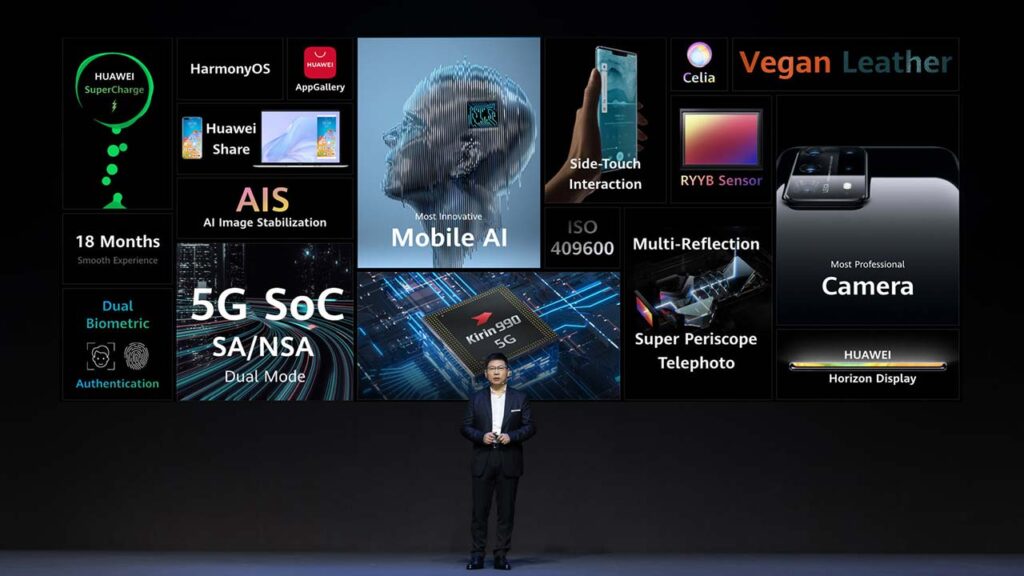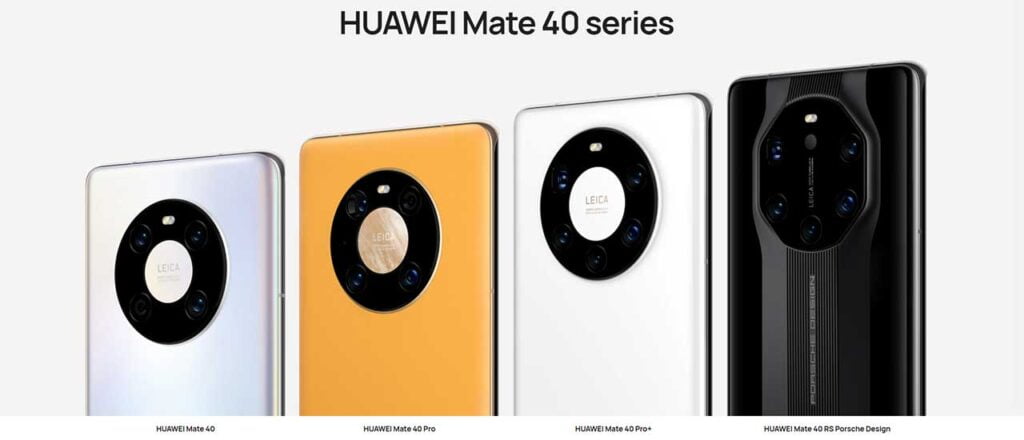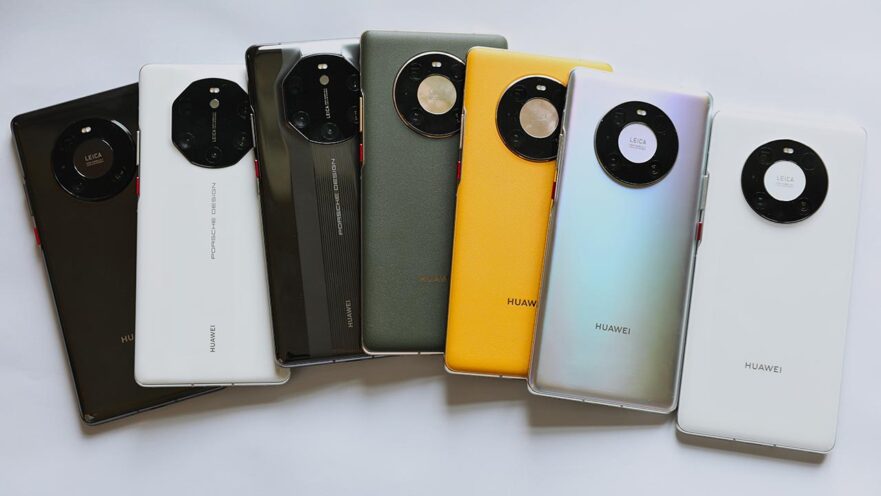Huawei has announced the Mate 40 series at a virtual event hosted by Huawei Consumer Business CEO and executive director Richard Yu. And as previously leaked, the Mate 40 lineup includes the Huawei Mate 40, Mate 40 Pro, and Mate 40 Pro Plus and Porsche Design Huawei Mate 40 RS.
(Update, December 1: Finally, the Huawei Mate 40 Pro’s Philippine price and release date…)
(Update, November 11: Check out our unboxing and initial review of the Huawei Mate 40 Pro!)
(Update, October 31: Over 720,000 benchmark score in Antutu? Look!)
(Update, October 23: Then: Xiaomi. Now: Huawei. Read Huawei Mate 40 Pro crowned best camera phone on DxOMark.)
The launch of the company’s latest flagship smartphones comes at a precarious time, with its smartphone future in question amid a trade spat between the United States and China, which has caught the tech giant between the world’s two superpowers. The ensuing sanctions and clampdown by the U.S. government, which Richard Yu referred to as “unfair” during the online launch, have effectively left Huawei without Google and its app ecosystem.

Huawei Consumer Business CEO and executive director Richard Yu at the Mate 40 series launch
Despite this, business is booming for Huawei. According to the latest Canalys research, the company actually gained global market share in the second quarter of 2020, even managing to beat Samsung as the world’s largest smartphone vendor for the first time, with 55.8 million units shipped accounting for 19.6% of the market.
In terms of global market share for smartphones above $600 (around P29,166), Huawei was the second-biggest vendor in the second quarter. Unsurprisingly, its premium-phone sales in China accounted for 51.1% of the market share for the same period; Apple was a far second with 37.6%.
At the Mate 40 launch, Yu reiterated Huawei’s commitment to bringing the best and most innovative products that make people’s lives easier. Curiously, there was no mention of Huawei’s in-house Harmony OS, which is expected to launch as early as next year on mobile devices.
Huawei Philippines has yet to announce a local launch date for the new Mate 40 phones. Perhaps we’ll see them in stores next month, still in time for the holiday-shopping season.
Presenting the #HUAWEIMate40 Series for your eyes only. Check it out again. 👇#LeapFurtherAhead pic.twitter.com/sIT5HsLono
— Huawei Mobile (@HuaweiMobile) October 22, 2020
Huawei Mate 40 series official product video
Huawei Mate 40 series prices and availability
The Huawei Mate 40, Mate 40 Pro, and Mate 40 Pro Plus and Porsche Design Huawei Mate 40 RS will be coming to Europe soon, with other markets including the Philippines likely to follow in the coming weeks. Prices for the European market are as follows:
- Huawei Mate 40 (8GB/128GB): €899 (P51,681 or $1,063)
- Huawei Mate 40 Pro (8GB/256GB): €1,199 (P68,927 or $1,418)
- Huawei Mate 40 Pro Plus (12GB/256GB): €1,399 (P80,425 or $1,655)
- Porsche Design Huawei Mate 40 RS (12GB/512GB): €2,295 (P131,934 or $2,714)
Do note that prices of consumer electronics in Europe tend to be higher than those in the Philippines because of higher taxes and other costs.
The Huawei Mate 40 and Mate 40 Pro will be available in Mystic Silver, Black, and White colors, while the vegan-leather options come in either yellow or green. The Mate 40 Pro Plus arrives with a ceramic back and only two colors: black and white. The Mate 40 RS has an octagonal camera setup on the back and sports a more aggressive design language with some cues from the Porsche brand.

All the Huawei Mate 40 series models
Huawei Mate 40 series features and specs
Physically, the Mate 40 series look impressive in pictures and videos. And regardless of which one you choose, you’ll be treated to a sizable OLED screen with curves on both sides and a built-in fingerprint reader. Better yet, all displays come with a 90Hz refresh rate and 240Hz touch-sampling rate.
#HUAWEIMate40 Series’ futuristic Space Ring Design takes inspiration from space and Sci-Fi.🌌Without any edges, it shows that we must never stop exploring.#LeapFurtherAhead pic.twitter.com/7tk7MyHZdr
— Huawei Mobile (@HuaweiMobile) October 22, 2020
Impressive-looking
Huawei says it could have easily put a faster screen on its latest flagships, but doing so would compromise battery life. Its 90Hz displays are said to offer the best balance between power efficiency and smoother performance.
Interact with your #HUAWEIMate40 Series device through a 90Hz refresh rate screen that offers beautifully smooth scrolling, 240Hz touch sampling rate, and excellent battery life.#LeapFurtherAhead pic.twitter.com/K287cWJAEV
— Huawei Mobile (@HuaweiMobile) October 22, 2020
The series’ 90Hz displays are said to offer the best balance between power efficiency and smoother performance
The Mate 40 can be easily distinguished by its smaller screen size — 6.5 inches across versus 6.76 inches on the Mate 40 Pro and Mate 40 Pro Plus. It’s a little flatter, too, with 68-degree curves compared with the 88-degree curves on the Pro models. The vanilla version’s resolution of 2,376 x 1,080 pixels is lower compared with the 2,772 x 1,344 resolution on the Mate 40 Pro and Mate 40 Pro Plus.
The Mate 40 also has a single punch hole for its selfie camera, while the other variants have pill-shaped cutouts for two cameras on the front. The selfie cameras on the Mate 40 phones allow for XD Fusion HDR video and super-slow-motion footage up to 240 frames per second.
Other notable hardware features of the Mate 40 series include stereo speakers that have 150% stronger bass response and an x-axis linear motor for better haptic response especially when gaming
Other notable hardware features of the series include capacitive inputs along the sides of the screen, stereo speakers that have 150% stronger bass response, an x-axis linear motor for better haptic response especially when gaming, an IP68 water- and dust-resistance rating (for the Pro variants), and a lot more.
Inside, the Huawei Mate 40 is powered by a Kirin 9000E chipset, while the Mate 40 Pro, Mate 40 Pro Plus, and Mate RS use a Kirin 9000. Both chips are manufactured by TSMC on a 5nm process. And although Apple was the first to launch 5nm devices, Huawei is the first OEM to offer 5nm chipsets with an integrated 5G modem.
That’s something to pay attention to, because built-in modems save on power usage, cost, and space. And Huawei (likely) rightfully points out that its 5nm processor should deliver better battery life over 5G compared to the A14 Bionic in the Apple iPhone 12.
Just like we promised, #HUAWEIMate40 Series’ delivers unprecedented power.
— Huawei Mobile (@HuaweiMobile) October 22, 2020
A 5nm Kirin 9000 chip powers over 15 billion transistors to provide rapid 5G speeds with better power efficiency.#LeapFurtherAhead pic.twitter.com/2EJ6fqpzAB
The Kirin 9000 is the first 5nm 5G SoC
Of course, what’s a new and more powerful silicon without performance claims? According to Huawei, the Kirin 9000 is 10% better than the Qualcomm Snapdragon 865 Plus in CPU tests, while the GPU runs 52% faster. The Kirin 9000’s NPU is said to be 2.4x faster than Qualcomm’s latest and greatest. When it comes to 5G speeds, it should provide higher uploads and downloads, too.
All Mate 40 phones ship with EMUI 11 based on Android 10. EMUI 11 brings several improvements over what came before, including an easier-to-use multi-window interface, highly customizable always-on options, useful AI gesture controls, and support for Huawei’s upgraded Multi-Screen Collaboration feature with the ability to interact with up to three apps at the same time on a laptop screen.
Our video preview of EMUI 11 from last September
The Huawei Mate 40 is equipped with a triple-camera module sans the periscope lens of its more expensive stablemates. The primary camera is 50 megapixels and has the same specs as the main shooters on the Pro models. Physically, it’s larger than other sensors on the market, and is claimed to offer better single-shot performance compared with other flagships with a triple-digit megapixel count, such as the Samsung Galaxy Note 20 Ultra.
The Mate 40 also gets dedicated ultra-wide and telephoto cameras. The latter is capable of achieving up to 5x maximum optical zoom, similar to what the Apple iPhone 12 Pro Max can do with its camera module.
In addition to the 50-megapixel main camera of the standard version, the Mate 40 Pro and Mate 40 Pro units feature Huawei’s second-generation Cine camera with a 20-megapixel sensor and an f/1.8 ultra-wide-angle, free-form lens. Huawei says the special optics allows for less distorted pictures and better-looking portraits.
There’s a 12-megapixel sensor behind a 125mm periscope lens as well. It comes with optical image stabilization, just like on the Huawei P40 Pro, and provides a maximum optical zoom of 7x. The Mate 40 Pro Plus, meanwhile, is capable of up to 17x optical zoom in total and 100x digital zoom.
Experience Ultra Vision with #HUAWEIMate40 Pro, which features dual ultra-wide cameras and distortion correction algorithms that let you make the most of them.#LeapFurtherAhead pic.twitter.com/tY4Ggo8oxI
— Huawei Mobile (@HuaweiMobile) October 22, 2020
Supposedly the ‘best dual ultra-wide cameras’
#HUAWEIMate40 Series’
— Huawei Mobile (@HuaweiMobile) October 22, 2020
Ring Light Case is like your 2-in-1 personal gaffer and protector.#LeapFurtherAhead pic.twitter.com/ZoeiMfwe4U
Will Huawei release this in the Philippines?
For better selfies, particularly in low light, you can fork out a little extra for a first-party case with a built-in LED ring light. The light automatically charges when not in use, thanks to the phone’s reverse-wireless-charging feature.
Both variants of the Mate 40 Pro include a 13-megapixel Cine selfie camera for up to 240 fps slo-mo video and group selfies. The camera is joined by a dedicated depth sensor, useful for face unlock and hands-free gesture navigation.
Finally, the regular Huawei Mate 40 gets a smaller 4,200mAh battery with slower, 40-watt wired charging and no wireless charging at all. Both the Mate 40 Pro and Mate 40 Pro Plus have a 4,400mAh capacity that can charge up to 66 watts, which is impressive. For cord cutters, the phones support 50-watt wireless charging, and reverse wireless charging is on the table as well.
Full video: Huawei Mate 40 series launch, in case you missed the livestream. Program starts at the 28:45 mark
Huawei Mate 40 specs
- 6.5-inch curved OLED display, 2,376 x 1,080 resolution, 90Hz refresh rate
- Octa-core 5nm Kirin 9000E processor with built-in 5G
- Mali-G78 MP22 GPU
- 8GB RAM
- 128GB storage
- Triple 50-megapixel, f/1.9 (main), 16-megapixel (ultra-wide), 8-megapixel (telephoto) rear cameras
- 16-megapixel, f/2.2 front camera
- Fingerprint reader (in-display)
- 4,200mAh battery with 40-watt USB-C charging
- EMUI 11 based on Android 10
- IP53 rating
- Color options: Mystic Silver, Black, White, Yellow (leather), Green (leather)
Huawei Mate 40 Pro specs
- 6.76-inch curved OLED display, 2,772 x 1,344 resolution, 90Hz refresh rate
- Octa-core 5nm Kirin 9000 processor with built-in 5G
- Mali-G78 MP24 GPU
- 8GB RAM
- 256GB storage
- Quad 50-megapixel, f/1.9 (main), 20-megapixel (Cine ultra-wide), 12-megapixel (periscope telephoto) with OIS, TOF 3D rear cameras
- 13-megapixel (Cine), f/2.4, TOF 3D front cameras
- Fingerprint reader (in-display)
- 4,400mAh battery with 66-watt USB-C charging, 50-watt wireless fast charging
- EMUI 11 based on Android 10
- IP68 rating
- Color options: Mystic Silver, Black, White, Yellow (leather), Green (leather)
Huawei Mate 40 Pro Plus specs
- 6.76-inch curved OLED display, 2,772 x 1,344 resolution, 90Hz refresh rate
- Octa-core 5nm Kirin 9000 processor with built-in 5G
- Mali-G78 MP24 GPU
- 12GB RAM
- 256GB storage
- Penta 50-megapixel, f/1.9 (main), 20-megapixel (Cine ultra-wide), 8-megapixel (periscope telephoto) with OIS, 12-megapixel (telephoto) with OIS, TOF 3D rear cameras
- 13-megapixel (Cine), f/2.4, TOF 3D front cameras
- Fingerprint reader (in-display)
- 4,400mAh battery with 66-watt USB-C charging, 50-watt wireless fast charging
- EMUI 11 based on Android 10
- IP68 rating
- Color options: Black (ceramic), White (ceramic)
Porsche Design Huawei Mate 40 RS specs
- 6.76-inch curved OLED display, 2,772 x 1,344 resolution, 90Hz refresh rate
- Octa-core 5nm Kirin 9000 processor with built-in 5G
- Mali-G78 MP24 GPU
- 12GB RAM
- 512GB storage
- Penta 50-megapixel, f/1.9 (main), 20-megapixel (Cine ultra-wide), 8-megapixel (periscope telephoto) with OIS, 12-megapixel (telephoto) with OIS, TOF 3D rear cameras
- 13-megapixel (Cine), f/2.4, TOF 3D front cameras
- Fingerprint reader (in-display)
- 4,400mAh battery with 66-watt USB-C charging, 50-watt wireless fast charging
- EMUI 11 based on Android 10
- IP68 rating
- Color options: Black (ceramic), White (ceramic)
Share this Post



